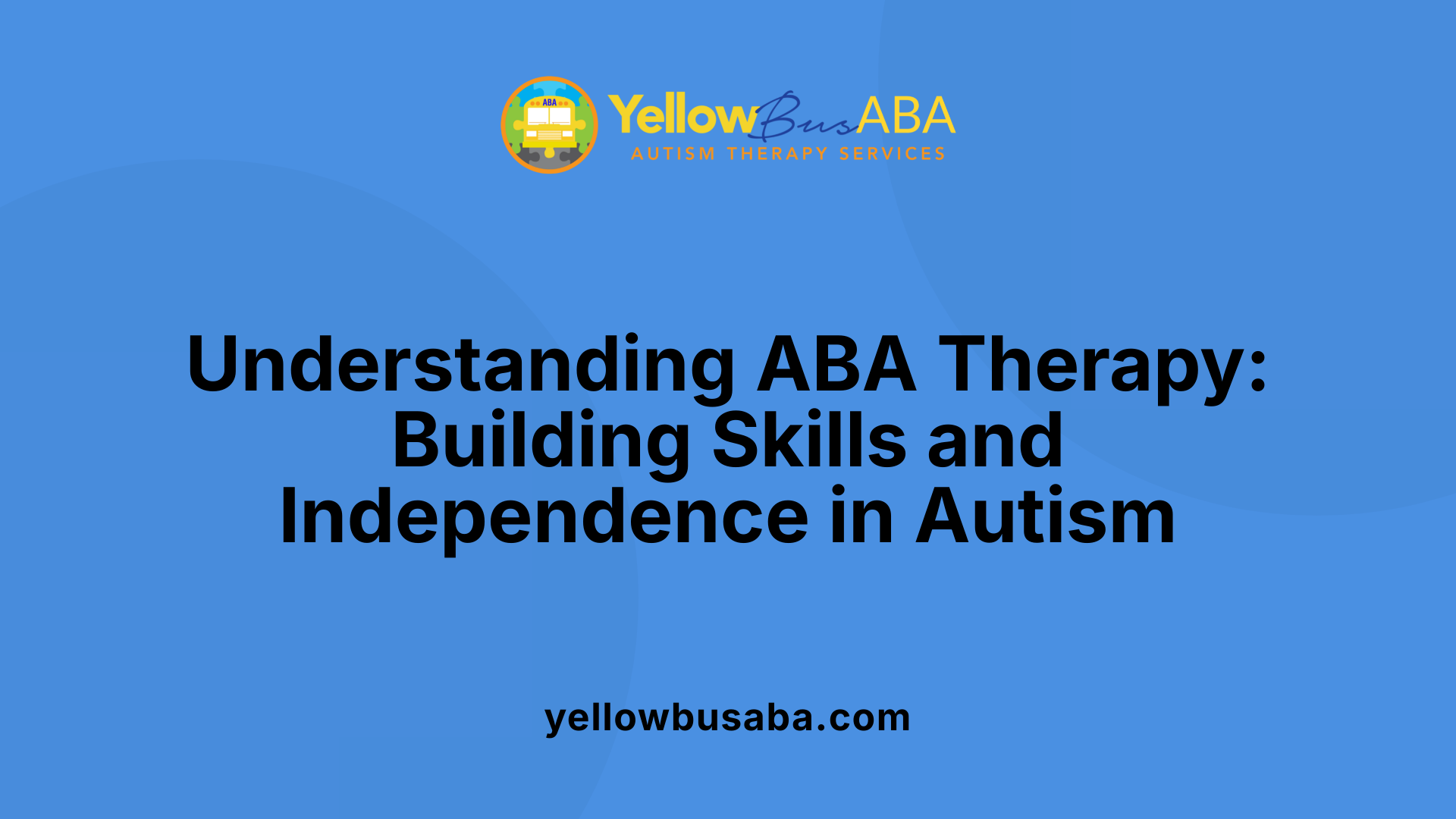Harnessing the Potential of Everyday Routines
Daily routines are often seen as mundane tasks, but for children with autism, they hold immense potential as platforms for learning and development. This approach leverages natural, repetitive activities—bathtime, mealtime, and play—to deliver effective therapy seamlessly integrated into family life. By embedding evidence-based behavioral strategies in everyday moments, children not only acquire essential skills but also gain independence and confidence in managing their world.
What is ABA Therapy and Its Role in Autism Support?

Definition of Applied Behavior Analysis (ABA) therapy
Applied Behavior Analysis (ABA) therapy is a scientifically grounded approach that focuses on modifying behavior through learning principles. It uses systematic techniques to teach functional skills while reducing behaviors that interfere with daily living.
Use of ABA principles in skill development and behavior management
ABA therapy breaks down daily routines into small, manageable tasks using task analysis. This step-by-step approach helps children with autism learn each part of a routine independently. Parents and therapists use ABA methods during typical activities like bathing, feeding, or playing to encourage skills such as communication and social interaction. For example, a child might be encouraged to request food during mealtime using gestures or words.
Evidence base and effectiveness of ABA for autism
Research supports ABA as an effective, evidence-based intervention. Intensive ABA programs, especially when started early, produce meaningful improvements in cognitive abilities, language, social skills, and independence. ABA is considered a gold standard in autism intervention due to its proven ability to foster developmental progress.
Key techniques: positive reinforcement, individualized plans, data collection
Central to ABA therapy is positive reinforcement; children receive praise, rewards, or tokens when they successfully complete tasks or exhibit desired behaviors. Visual schedules using pictures reduce anxiety about transitions by clarifying expected activities. Data collection guides adjustments to individualized treatment plans tailored to each child's unique needs.
Roles of qualified professionals delivering ABA therapy
ABA therapy is conducted by trained professionals, such as Board Certified Behavior Analysts (BCBAs) and therapists. These experts design and oversee intervention plans, coach families, and ensure consistent implementation across settings, maximizing the therapy's benefits.
Overall, ABA therapy systematically supports children with autism in mastering daily routines, improving communication, and enhancing social skills, leading to greater independence and confidence.
Who Provides ABA Therapy and How Is It Delivered?

Professionals Involved in ABA Therapy Delivery
ABA therapy for individuals with autism is typically delivered by a team of trained and credentialed professionals. The most qualified among these are Board Certified Behavior Analysts (BCBAs), who design and oversee individualized treatment plans. They usually hold master's degrees in psychology, developmental sciences, or related fields. Supporting the BCBA, Board Certified Assistant Behavior Analysts (BCaBAs) assist in creating and monitoring programs.
Roles of BCBAs, BCaBAs, RBTs, and Paraprofessionals
Registered Behavior Technicians (RBTs) and paraprofessionals are vital members who work directly with children. They implement therapy by following the BCBA's guidance, collecting data, and helping children learn daily routines step-by-step. This hands-on approach ensures skill acquisition through consistent practice and positive reinforcement.
Parental Involvement and Caregiver Training
A crucial part of ABA therapy is training parents and caregivers. They learn to embed teaching opportunities into everyday routines like bathing, feeding, and play. This family-guided approach transforms daily activities into effective therapy moments, making learning natural and continuous.
Team Approach in Therapy Implementation
Effective ABA therapy depends on collaboration among professionals, caregivers, and educators. This team approach tailors interventions to each child's unique needs, supports generalization of skills across settings, and ensures consistency throughout the day.
Credentialing and Qualifications
Professionals providing ABA therapy hold certifications ensuring they meet ethical and competency standards. BCBAs and BCaBAs complete rigorous training and ongoing education, while RBTs acquire foundational skills and work under supervision. This credentialing guarantees that therapy is evidence-based and delivered with quality.
The combination of expert guidance, direct therapy implementation, and caregiver involvement makes ABA therapy a comprehensive, effective approach to fostering skill development and independence in children with autism.
Behavioral Therapy Goals in Autism Support

What are the main goals of behavioral therapy in the context of autism support?
Behavioral therapy, especially applied behavior analysis (ABA), focuses on several important goals to support children with autism. One of the primary aims is to increase adaptive and helpful behaviors while reducing harmful or disruptive ones. This balance helps the child function more smoothly in daily life.
Communication and social skill improvement is another crucial objective. Through routines like mealtimes or play, therapy encourages children to use verbal requests, gestures, and social interactions. For example, parents may guide children to ask for food during dinner using words or pictures. Social skills are gradually developed, helping children better engage with family and peers.
Developing daily living skills and fostering independence form a core part of behavioral therapy goals. This involves breaking down complex tasks such as bathing, dressing, or tooth brushing into smaller steps using task analysis. Positive reinforcement like praise or token rewards supports children to complete these activities confidently.
Goals are always customized to the individual's unique needs and family context. Family-guided routines-based intervention ensures consistency across all daily activities, turning natural moments like diaper changes or gardening into productive learning opportunities. Visual schedules and sensory-sensitive strategies address specific challenges like transitions and communication barriers, helping reduce anxiety and build flexibility.
Overall, behavioral therapy strives to enhance quality of life by enabling children with autism to manage daily routines independently, communicate effectively, and interact socially. Through systematic teaching and reinforcement, therapy promotes growth across communication, social, and life skills domains tailored to the child's own development pathway.
Family-Guided Routines Based Intervention: Integrating Therapy into Daily Life

What is Family-Guided Routines Based Intervention (FGRBI)?
Family-Guided Routines Based Intervention (FGRBI) is a research-supported method designed to weave therapeutic activities into the fabric of everyday family life. This approach transforms routine tasks—like bathing, feeding, and playing—into consistent learning moments for children with disabilities.
Who implements FGRBI?
All family members and service providers participate in the daily execution of FGRBI. By working together throughout the day, they turn normal household activities into effective chances for intervention and skill-building.
How are everyday activities used in this approach?
Instead of setting aside separate times for therapy, FGRBI blends intervention strategies directly into usual care routines. For instance, parents might encourage a child to communicate during mealtimes or use praise to reinforce desired behaviors during bedtime rituals.
Why are natural learning environments beneficial?
Natural settings offer repetitive, meaningful experiences that promote learning more naturally and comfortably. Children practicing skills within familiar daily routines often achieve better outcomes, gaining independence and confidence while minimizing stress.
Through family involvement and the use of daily living activities, FGRBI creates a seamless, supportive framework that helps children with disabilities thrive in their everyday environments.
Utilizing Daily Routines to Foster Communication and Social Skills

How are ABA techniques applied during routine activities?
Applied Behavior Analysis (ABA) therapy breaks down daily routines into manageable steps through task analysis. This helps children with autism learn each part of an activity independently. For example, during routines like bathing or car rides, parents and caregivers can use positive reinforcement techniques such as verbal praise or tangible rewards. Visual schedules featuring pictures or icons also assist children in understanding expected tasks, easing transitions and reducing anxiety.
How can requesting skills be encouraged through pointing, pictures, or verbalizations?
Parents can encourage children to request desired items or activities during daily routines by prompting communicative behaviors. At dinnertime, a child might be supported to ask for food by pointing, using picture cards, or verbal requests. This consistent practice embeds communication into natural settings, strengthening language development as children learn functional ways to express wants and needs.
What role do rewards and token systems play in routines like bedtime?
In routines such as bedtime, rewards and token systems serve as motivation for children to learn appropriate behaviors and social skills. Steps like taking a bath, brushing teeth, and putting on pajamas can be reinforced with praise or tokens. These reinforcements make the routine enjoyable and encourage the child to complete each step successfully, enhancing both behavioral skills and independence.
How do interactive activities like gardening or cleaning promote language development?
Incorporating engaging, fun activities like gardening or cleaning invites children to practice language skills naturally. For instance, while gardening, children might label the colors of flowers, fostering vocabulary growth. Clean-up routines can be enhanced with song-based interactions, encouraging participation and communication. Such interactive routines not only build language but also encourage social interaction and engagement.
| Routine Activity | ABA Strategies Applied | Communication & Social Benefits |
|---|---|---|
| Bathing & Bedtime | Task analysis, token systems | Promotes step completion and appropriate behaviors |
| Mealtime | Encouraging requests via pointing or pictures | Builds functional communication skills |
| Gardening & Cleaning | Interactive songs and labeling | Enhances vocabulary and social interaction |
| Car Rides | Visual schedules and reinforcement | Reduces anxiety, supports independence |
Breaking Routines Down: Task Analysis and Visual Supports
How does task analysis help in teaching children daily routines?
Task analysis breaks down daily routines into smaller, manageable steps, making tasks easier for children to learn and complete independently. For instance, a routine like bathing is divided into steps such as turning on water, washing, rinsing, and drying. This step-by-step approach offers clear guidance and helps children master each part sequentially, fostering skill development and independence.
What role do visual schedules play in supporting children during routines?
Visual schedules use pictures or icons to represent each step of a routine, helping children understand what to expect next. These schedules reduce anxiety about transitions by providing clear structure and predictability. Children can follow the visual cues to complete tasks, which supports autonomy and can lessen frustration during changes in routine.
How does positive reinforcement improve task completion?
Positive reinforcement, like verbal praise or tangible rewards, motivates children to engage actively in routines and complete tasks successfully. Using rewards during activities such as putting on pajamas or brushing teeth encourages repetition of desired behaviors, making routines more enjoyable and effective. This strategy supports lasting behavior change by linking effort to positive outcomes.
How are tailored ABA strategies used to address common challenges?
ABA therapy applies specific strategies to overcome transitional difficulties, sensory sensitivities, communication barriers, and social challenges. Visual cues aid transitions, sensory breaks help manage sensitivities, picture exchange systems enhance communication, and social stories prepare children for social situations. These adaptations personalize support, enabling children to navigate routines with greater ease and confidence.
Impact of Embedding ABA Strategies in Everyday Activities
How does embedding ABA strategies in daily routines improve independence, flexibility, and confidence?
Embedding Applied Behavior Analysis (ABA) strategies in everyday activities helps children with autism develop independence by breaking down complex tasks into manageable steps through task analysis. This approach enables children to learn and complete each part of a routine on their own, boosting their confidence. The use of positive reinforcement, such as verbal praise or tangible rewards, encourages children to persist and enjoy routine activities, supporting flexibility in adapting to various daily situations.
How do ABA strategies assist with managing transitions and sensory challenges?
ABA therapy incorporates visual schedules featuring pictures or icons to clarify expected tasks and ease anxiety over transitions. Tailored interventions also consider sensory sensitivities by including sensory breaks when needed. Techniques like social stories and picture exchange systems help children prepare for and navigate changes in routine while improving communication skills, making transitions smoother and less stressful.
Can ABA techniques embedded in routines help generalize skills beyond therapy sessions?
Yes, implementing ABA during natural daily activities—such as feeding, bathing, or playtime—facilitates the generalization of learned skills. When children practice communication and social behaviors in real-life contexts, like asking for food during dinner or labeling colors while gardening, these skills become functional and transferable beyond formal therapy sessions.
How does embedding ABA in daily routines enhance overall quality of life and functional capabilities?
Integrating ABA strategies into family-guided routines transforms daily activities into therapeutic opportunities, leading to meaningful improvements in behavior and social skills. This holistic approach fosters greater independence and emotional regulation, enabling children to better handle daily demands and social interactions. As a result, their overall quality of life and functional abilities improve, benefiting both the child and their family.
| Aspect | Approach | Examples |
|---|---|---|
| Independence & Confidence | Task analysis and positive reinforcement | Breaking routines into steps; rewarding task completion |
| Transitions & Sensory Challenges | Visual schedules, sensory breaks, social stories | Using pictures to prepare for changes; sensory accommodations |
| Skill Generalization | Embedding ABA in natural routines | Practicing requests during mealtime; labeling during play |
| Quality of Life | Family-guided routines, consistent interventions | Turning daily activities into therapy; improving social behaviors |
Everyday Moments as Catalysts for Lasting Growth
Incorporating ABA therapy techniques within everyday routines transforms ordinary tasks into powerful learning experiences for children with autism. This integration fosters skill acquisition organically and supports behavioral progress in natural settings, promoting generalization and independence. Through a collaborative effort involving trained professionals and family members, daily life becomes a continuous therapeutic journey—where each bath, meal, and playtime serves as a stepping stone toward greater communication, social participation, and self-sufficiency. Embracing this approach empowers families to harness the learning potential embedded in their daily lives, paving the way for meaningful developmental milestones and enriched quality of life.
References
- Using ABA in Everyday Routines to Help Develop Skills
- How ABA Therapy Helps with Daily Routines
- Applied Behavior Analysis (ABA)
- Applied Behavior Analysis (ABA)
- What Is Applied Behavior Analysis (ABA)?
- Applied Behavior Analysis (ABA)
- Behavioral Therapy for Autism Spectrum Disorder in Children
- Treatment and Intervention for Autism Spectrum Disorder
- ABA Therapy Goals: 25 Practical Examples & Timelines
- Applied Behavior Analysis (ABA)


.jpg)
.avif)


